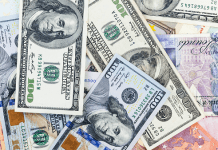- Japanese Yen (JPY) falls after gains last week
- Safe haven outflows also pull the yen lower
- US Dollar (USD) rises versus its major peers
- 50 basis point rate cut expectations ease
The US Dollar Japanese Yen (USD/JPY) exchange rate is rising after losses last week. The pair fell 2.8% in the previous week, settling on Friday at 142.27. At 20:00 UTC, USD/JPY trades +0.43% at 142.88 and is in a range of 142.43 to 143.80.
The yen is flying at the start of the week after Japanese economic growth was weaker than initially reported in the second quarter. Japanese Q2 GDP grew 0.7% quarter on quarter a downward revision from the 0.8% in the preliminary reading.
Weaker growth gives the Bank of Japan less headroom to need to cut to hike interest rates further.
The yen is also falling on safe-haven outflows as the market mood improves following last week’s hit to sentiment.
The US Dollar is rising across the board. The US Dollar Index, which measures the greenback versus a basket of major currencies, trades at 101.56 at the time of writing, up 0.37%, after losses last week.
The US dollar is rising after losses in the previous week as the market reassesses the likelihood of the Federal Reserve bringing an outsized rate cut next week.
Weak data throughout most of last week raised concerns of a hard landing in the US and boosted the prospect of a 50-basis-point rate cut by the Federal Reserve when it meets in mid-September.
However, mixed non-farm payroll data on Frida resulted in the market reining back expectations of a larger rate cut and favoring a 25 basis point rate cut. The market is pricing in a 75% chance of a 25 basis point cut, up from 60% last week,
On Friday, the non-farm payroll report showed weaker-than-expected job creation and a large downward revision to job creation in the previous two months. However, the unemployment rate also ticked lower to 4.2% easing concerns that the U.S. jobs market is collapsing.
This week’s attention will be on Wednesday’s inflation data, which is the last piece of the jigsaw before next Wednesday’s Federal Reserve report.





